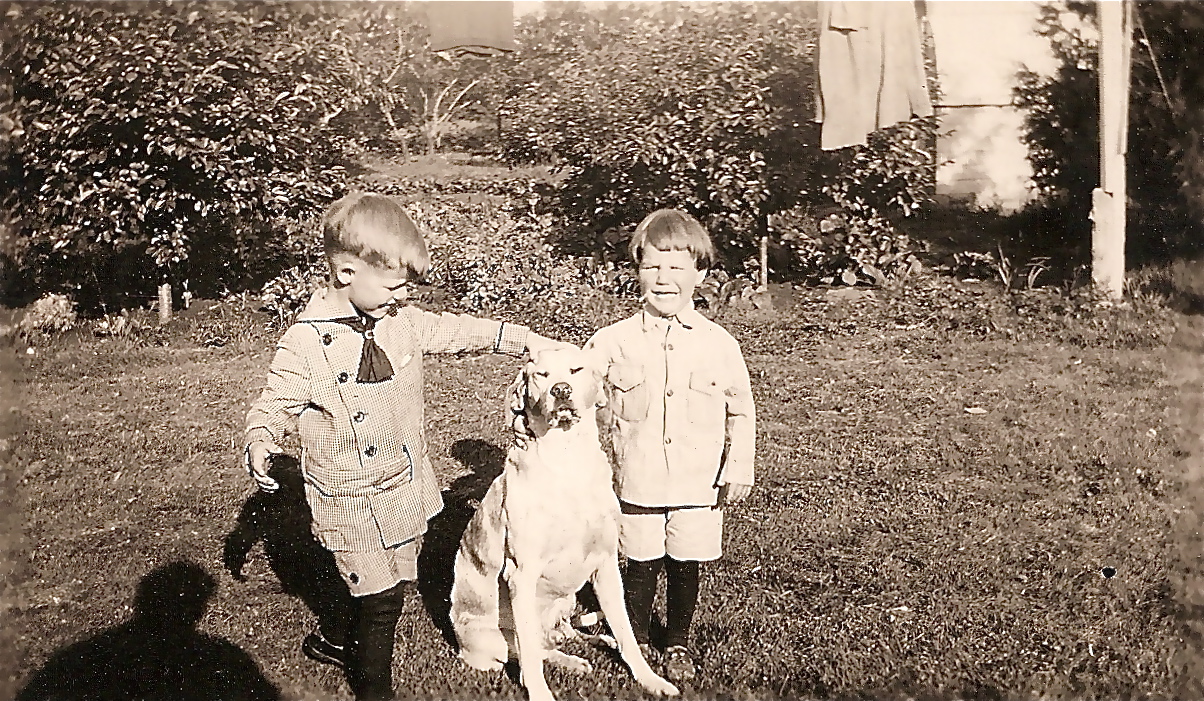|
Moderated by NW Okie! |
Volume 13 , Issue 182011Weekly eZine: (375 subscribers)Subscribe | Unsubscribe Using Desktop... |
NW Okie's Ancestrial Lineage

[The photo on the left is another photograph of Gene and Bob McGill, taken June 1919, with a bird dog, in Alva, Woods, Oklahoma.]
I would like to send a thousand "Thank You" to someone out there that just sent me and the McGill family our Uncle Robert "Bob" Lee McGill's World War II medals. WOW! Thank you so much, Monet Monfort Lion, for sending us Uncle Bob's WWII medals. There is not enough "Thank You's" to say how much we appreciate what you have done.
Although, I have NOT found a connection to the following LUTTRELL ancestors, maybe some of this information will help other LUTTRELL descendants out there. This is why this week's OkieLegacy ezine is dedicated to those descendants of LUTTRELL ancestors.
Last week we gave some information concerning our MCGILL Lineage leading to the LUTTRELL / CRAIGHEAD connection, of Hamilton County, Tennessee, that married into our MCGILL lineage and wanting to know more about the LUTTRELL lineage.
After much browsing online through Google books and Ancestry.com, we have learned more about the LUTTRELL lineage that dates back to the early thirteenth century near Luttrellstown, County Dublin, ireland. If you follow the lineage of these LUTTRELL's of Dunster Castle in Ireland, it leads you to the LUTTRELL (Robert the 2nd) that the American LUTTRELLS descended from and settled around Prince Willaim county, Virginia and finally settling in Hamilton county, Tennessee.
BUT . . . We have NOT found that specific connection that connects them to our MCGILL / CRAIGHEAD / LUTTRELLL family lineage yet!
It was particularly interesting searching for English ancestors this week while the wedding of the Duke and Duchess of Cambridge (William and Kate) was transpiring in England this weekend. this NW Okie was glued to the tellie!
Did you know that Westminister Abbey (its formal name, the Collegiate Church of St. Peter) has been the coronation church since 1066 and is the final resting place of seventeen monarchs?
Kings and queens have been significant benefactors of the Abbey, beginning with King Edgar (reigned 959-75) who gave the original monastic community at Westminster substantial lands covering most of what is now the West End of London. Almost a hundred years later King Edward (later Edward the Confessor) established his palace close to this monastic community and built for it a large stone church which became his own burial place. In the mid-thirteenth century Henry III rebuilt the Confessor's church, providing the Gothic building we have today.
Henry's own burial here in 1272 established Westminster as the principal royal burial place for the next 500 years. Richard II, Henry V, Henry VII and Elizabeth I were all influential in shaping the Abbey's history.
Westminster, is a "Royal Peculiar" -- meaning it is a free chapel of the Sovereign, exempt from any ecclesiastical jurisdiction other than that of the Sovereign. Royal Peculiars originated in Anglo-Saxon times and developed as a result of the unique relationship between the Norman and Plantagenet Kings and the English Church.
In 1222 the Abbey was declared a Papal Peculiar, exempt from the jurisdiction of both the Bishop of London and the Archbishop of Canterbury. It has been a Royal Peculiar since 1533 when the Ecclesiastical Licences Act, as confirmed by the Act of Supremacy of 1559, transferred to the Sovereign the jurisdiction which had previously been exercised by the Pope. Other Royal Peculiars include St George's Chapel at Windsor Castle and the Chapels Royal.
Good Day & Good Luck in searching your ancestors!
| View or Add Comments (0 Comments)
| Receive
updates ( subscribers) |
Unsubscribe
| © . Linda Mcgill Wagner - began © 1999 Contact Me | |
